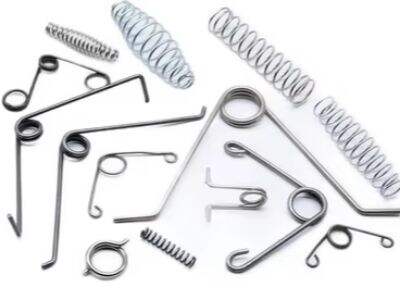Springs are interesting things we see in everyday. Interesting, right? Ever wondered why are they so important and useful? What makes springs so fascinating is their ability to accumulate elastic potential energy. And release it upon demand. Some of them are out there in a lot of different sizes, and we use these all the time to make everything from toys you play with or even machines that help people. Now that we know the main kinds of springs fall in one of those two categories, let us dive into detail on what each type is: Torsion Springs, Compression Springs, Extension Spring, Constant Force Springs. All of these have their particular way of doing things which allow us to solve certain types problems.
Types of Springs
Torsion Springs are helical springs where the active material is twisted wire. They hold energy when you twist them. This is what enables them to be exploited once they are deployed. Torsion Springs: Torsion springs can be seen in the spring of clocks. They help to move the hands of a clock so that it can keep correct time. You may also find them in toys that spring or crank back-and-release.
Compression Springs: Compression springs are loose and flimsy. Their major use is that when we press them, they are made to store energy. At the time spring action of pen. The spring compresses when you press down on the pen and expands back out as soon as you let go. They are used for the car suspensions as well which helps to make driving smoother when going over potholes.
Extension Springs – Extension springs are a little different. They are coil and can stretch when yanked. They store a nimble energy in them every time you stretch up. Trampolines Use Extension Springs: So any time you jump on a trampoline, the extension springs stretch or expand and then snap back into place to bounce you in another direction. They are also used in garage doors so that they can easily lift up and down the door.
Constant Force Springs: they push with equal force regardless of how much the spring has been stretched or compressed This makes them able to exert a constant force over long ranges. You would know these as those open-ended spring washer you see in tape measures. The spring helps to return the tape back in when you pull it out. They also serve as pull chords in window shades to simplify their opening and closing.
Choosing the Right Spring
The proper selection of a spring is crucial for your application or requirement. Each spring has its strengths and you need to carefully assess what is required for your application. For a spring that you need to hold doors open, an extension coil will be the best solution as it is able stretch and still keep whatever door in position. However, if you were searching for a spring to put inside of a toy so it can hop up and down or spin in circles when made, that would be termed as torsion springing works better because they are designed grunt energy via twisting.
You will also need to take into account the weight of what you are going to put on top, in order to choose a spring. The Spring Loaded Captive Screws by JIUDING needs to be strong enough and provide the correct amount of force to do what it was designed for. The ones made of durable spring will work the best and last longer, preventing cracks or any other kind of damages incurred during physical force.
How Springs Work?
The general principle behind all springs is the same: Springs are elastic—a spring balances a force and acts as an energy store, returning to its original position when released. How much energy, or how steeply you push on a spring determines the volume of it that can be held. An example of this is how torsion springs work by storing their energy through twisting, which allows them to release the energy quickly. Compression springs are usually operated with the help of a push, and extension spring stores an energy by stretching it away. The reason that the constant force spring is one type of them which used mainly for continuous push force.
Why Quality Springs Matter?
If you select a spring, quality should be considered very seriously. Pick the one that is not good and you may soon face a broken spring or less than satisfactory functioning. Low-grade springs may not be strong enough for the forces placed on them, creating a dangerous situation. This is why it is important that you select a high quality spring made of durable material. You should also consider manufactures who you can trust to help you find the spring that is right for what your needs are.
So, to recap—the spring is everywhere in our daily life; we live surrounded by its power and might even not recognize it. Knowing the differences between the aforementioned types of springs can help us make our decisions while choosing a spring, based on what they will be used for. Whether you are building a toy, repairing an engine or performing construction of any kind; choosing the right spring is crucial to both safety and functionality. If you have access to at least some information about what your springs need to do and get support from a reputable provider, there is no reason that the spring you are using will not be of high quality able to meet even your most demanding needs for any project.

 EN
EN







































/images/share.png)
